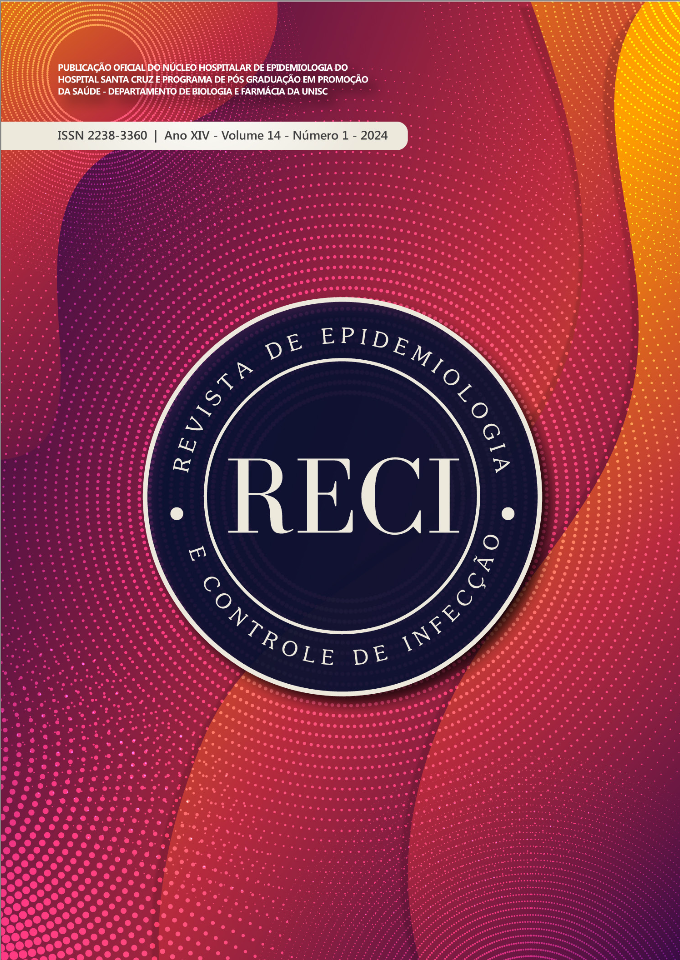Antimicrobial prescription and bacterial resistance in a Brazilian Intensive Care Unit
DOI:
https://doi.org/10.17058/reci.v14i1.19024Keywords:
Anti-Bacterial Agents, Drug Resistance, Microbial, Intensive Care Units, Laboratory TestAbstract
Background and Objectives: antimicrobial resistance is one of the main public health concerns worldwide. Intensive Care Units have a high prevalence of resistant microorganisms and infections, and the rational use of antibiotics is one of the main strategies for tackling this problem. This work aimed to describe patterns associated with antimicrobial drugs as well as the resistance profile of microorganisms. Methods: an observational study was carried out using data from patients hospitalized in the Intensive Care Unit who used antimicrobial agents. Results: respiratory and cardiological causes were the most frequent reasons for admission, with cephalosporins (29.02%), with penicillin (25.84%) and macrolides (16.10%) being the most used classes of antibiotics. The predominant microorganisms were Klebsiella pneumoniae (13.98%), Staphylococcus aureus (13.44%) and Acinetobacter baumannii (11.83%). Urine cultures and tracheal aspirate were the culture tests with the highest growth of gram-negative microorganisms. Patients with bacteria isolated in tracheal aspirate had longer hospital stays; 20 patients had positive surveillance cultures; and the mortality rate found was 55.45%. Conclusion: the study combined the institution’s epidemiological profile with patient characteristics, isolated microorganisms and outcomes.
Downloads
References
Plantinga NL, Wittekamp BH, Van Duijn PJ, et al. Fighting antibiotic resistance in the intensive care unit using antibiotics. Future Microbiol. 2015;10(3):391-406. https://doi.org/10.2217/fmb.14.146.
Pulingam T, Parumasivam T, Gazzali AM, et al. Antimicrobial resistance: Prevalence, economic burden, mechanisms of resistance and strategies to overcome. Eur J Pharm Sci. 2022;170:e106103. https://doi.org/10.1016/j.ejps.2021.106103.
Axente C, Licker M, Moldovan R, et al. Antimicrobial consumption, costs and resistance patterns: A two year prospective study in a Romanian intensive care unit. BMC Infect Dis. 2017;17:358. https://doi.org/10.1186/s12879-017-2440-7.
Willmann M, El-Hadidi M, Huson DH, et al. Antibiotic selection pressure determination through sequence-based metagenomics. Antimicrob Agents Chemother. 2015;59:7335-45. https://doi.org/10.1128/aac.01504-15
Jung SH, Ryu CM, Kim JS. Bacterial persistence: Fundamentals and clinical importance. J Microbiol. 2019;10:829-35. https://doi.org/10.1007/s12275-019-9218-0.
Saxena S, Priyadarshi M, Saxena A, et al. Antimicrobial consumption and bacterial resistance pattern in patients admitted in I.C.U at a tertiary care center. J Infect Public Health. 2019;12:695-9. https://doi.org/10.1016/j.jiph.2019.03.014.
Rudd KE, Johnson SC, Agesa KM, et al. Global, regional, and national sepsis incidence and mortality, 1990–2017: analysis for the Global Burden of Disease Study. Lancet. 2020;395:200-11. https://doi.org/10.1016/S0140-6736(19)32989-7.
Vincent JL, Sakr Y, Singer M, et al. Prevalence and Outcomes of Infection among Patients in Intensive Care Units in 2017. JAMA. 2020; 323:1478-87. https://doi.org/10.1001/jama.2020.2717.
Karabatsou D, Tsironi M, Tsigou E, et al. Variable cost of ICU care, a micro-costing analysis. Intensive Crit Care Nurs. 2016;35:66-73. https://doi.org/10.1016/j.iccn.2016.01.001.
Vincent JL, Rello J, Marshall J, et al. International Study of the Prevalence and Outcomes of Infection in Intensive Care Units. JAMA. 2009;302:2323-9. https://doi.org/10.1001/jama.2009.1754.
Stocker H, Mehlhorn C, Jordan K, et al. Clinical and economic effects of an antimicrobial stewardship intervention in a surgical intensive care unit. Infection. 2020;48:509-19. https://doi.org/10.1007/s15010-020-01421-8.
Sabino SS, Lima CA, Machado LG, et al. Infections and antimicrobial resistance in an adult intensive care unit in a Brazilian hospital and the influence of drug resistance on the thirty-day mortality among patients with bloodstream infections. Rev Soc Bras Med Trop. 2020; 53:e20190106. https://doi.org/10.1590/0037-8682-0106-2019.
Mota FS, Oliveira HA, Souto RCF. Perfil e prevalência de resistência aos antimicrobianos de bactérias Gram-negativas isoladas de pacientes de uma unidade de terapia intensiva. Revista Brasileira de Análises Clínicas. 2018;50(3):270-7. https://doi.org/10.21877/2448-3877.201800740
Silva ARA, Jaszkowski E, Schober T, et al. Patterns of antimicrobial consumption in neonatal and pediatric intensive care units in Germany and Brazil. Eur J Clin Microbiol Infect Dis. 2020;39:249-55. https://doi.org/10.1007/s10096-019-03714-9.
Timsit JF, Bassetti M, Cremer O, et al. Rationalizing antimicrobial therapy in the ICU: a narrative review. Intensive Care Med. 2019;45:172-89. https://doi.org/10.1007/s00134-019-05520-5.
Sick-Samuels AC, Woods-Hill CZ, Fackler JC, et al. Association of a blood culture utilization intervention on antibiotic use in a pediatric intensive care unit. Infect Control Hosp Epidemiol. 2019;40:482-90. https://doi.org/10.1017/ice.2019.10.
Henderson JT, Webber EM, Bean SI. Screening for Asymptomatic Bacteriuria in Adults: Updated Evidence Report and Systematic Review for the US Preventive Services Task Force. JAMA. 2019;322:1195-205. https://doi.org/10.1001/jama.2019.10060.
Caskurlu H, Kocoglu ME, Cag Y, et al. Examination of blood and tracheal aspirate culture results in intensive care patients: 5-year analysis. Medeni Med J. 2020;35:128-35. https://doi.org/10.5222/MMJ.2020.89138.
O’Neill J. Tackling drug-resistant infections globally: final report and recommendations. Review on Antimicrobial Resistence. HM Government and Wellcome Trust; 2016. Disponível em: https://amr-review.org/Publications.html.
Dagli O, Tasdemir E, Ulutasdemir N. Palliative care infections and antibiotic cost: a vicious circle. Aging Male. 2020;23:98-105. https://doi.org/10.1080/13685538.2019.1575353.
Downloads
Published
How to Cite
Issue
Section
License
Copyright (c) 2024 Lucia Collares Meirelles, Vera Lúcia Milani Martins , Diogo Pilger

This work is licensed under a Creative Commons Attribution 4.0 International License.
The author must state that the paper is original (has not been published previously), not infringing any copyright or other ownership right involving third parties. Once the paper is submitted, the Journal reserves the right to make normative changes, such as spelling and grammar, in order to maintain the language standard, but respecting the author’s style. The published papers become ownership of RECI, considering that all the opinions expressed by the authors are their responsibility. Because we are an open access journal, we allow free use of articles in educational and scientific applications provided the source is cited under the Creative Commons CC-BY license.


